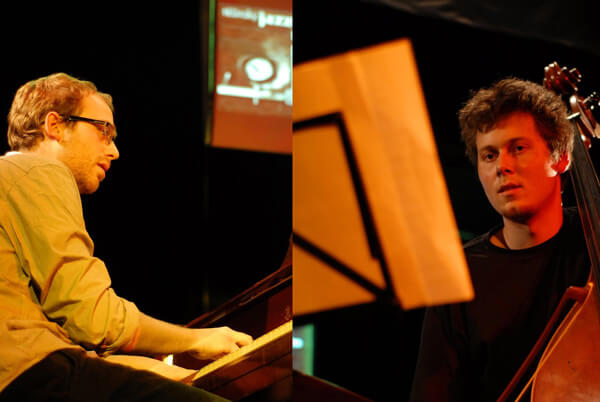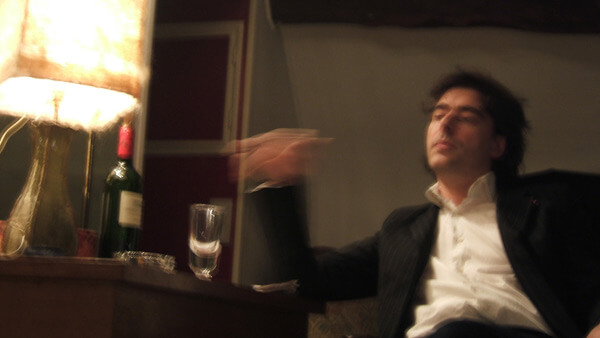 I’m a regular visitor to Hall Two at Kings Place, London, and it was lovely to see how well lighting can transform the space into something rather apt for this concert as part of ‘The Base’ jazz programme at the venue. The musicians performing shared not only links with jazz through their experimental improvisation but between them share an interest with the music of contemporary composers including Ligeti and Nancarrow particularly through their rhythmic materials. The audience was noticeably poised at this event and I don’t recall hearing a single cough throughout the whole evening; says a great deal about the music and most importantly about the performers.
I’m a regular visitor to Hall Two at Kings Place, London, and it was lovely to see how well lighting can transform the space into something rather apt for this concert as part of ‘The Base’ jazz programme at the venue. The musicians performing shared not only links with jazz through their experimental improvisation but between them share an interest with the music of contemporary composers including Ligeti and Nancarrow particularly through their rhythmic materials. The audience was noticeably poised at this event and I don’t recall hearing a single cough throughout the whole evening; says a great deal about the music and most importantly about the performers.

Jiri Slavek and Fred Thomas
The bassist Jiri Slavik with the pianist Fred Thomas (part of the F-IRE Collective) opened the evening with a series of pieces some of which were composed, some freely improvised. With no programme notes for the event we weren’t told any titles but it was clear that these were musicians that were indeed in creative synergy. Their opening piece demonstrated the beautiful sound Slavik can produce; his bass harmonics were precise and wonderfully in tune, accompanied by an inventive harmonic progression on the piano. There was a real sense of evolution; the piece seemed to unfold before our eyes and fragmentary gestures would shift in and out of focus and lines grow. The ear was subject to textural intrigue throughout, one such texture being the polarised passage—the extremes of the piano—which was reminiscent of Messiaen. Particularly virtuosic was the dynamic control and pacing, with incredible breadth made possible by their superb technique. The second piece was virtually all pizzicato bass with some intriguing double-stops; a low cluster on the piano eventually signalling a change of direction and like the first piece there was a sense of growth and development of material that was organic yet carefully controlled. This piece demonstrated how skilfully Slavik navigates the entire range of the bass, all with precision and a beautiful tone throughout.
There was something nostalgic about the duo’s third item through the quotation of pre-existing material (something medieval perhaps); lugubrious lines in the bass, creative harmonies in the piano which developed into something rhythmically like a tango with the bass accompanying the piano. The fourth piece opened with Thomas cleverly using a book to create clusters – played repeatedly but without the keys rising fully and through the repetition different pitches were highlighted each time. The subtle waves in dynamics that coloured these cluster chords reminded me of Reich’s New York Counterpoint, and they were an inventive backdrop to the gestures on the bass. I loved the sul tasto harmonics (on the fingerboard, Ed.) in this piece and the quotation of a Ligeti piano etude that demonstrated incredible virtuosity in Slavik’s rapid pizzicato. Slavik introduced their last item, a piece by drummer Paul Motion called It should have happened a long time ago. A lyrical melodic line and expressive harmonies made for a sonorous blend between Thomas and Slavik. Their set was compelling and the audience were nothing but mesmerised by their programme.

Benoit Delbecq (Kids… don’t drink and take pictures)
The pianist Benoît Delbecq had the second half to display his inventive work for solo piano, and through preparations inside the piano we were willed to listen to a musical narrative that used conventional timbres set against his preparations. His first piece (Circles and Calligrams) showed some interesting colours through preparations in the piano of particular registers; through obsessive repetition of ostinati on these prepared sections of the keyboard, we heard right hand gestures of a more familiar jazz rhetoric dancing down the piano. His second piece involved muting (with blu-tac) and again the right hand took prominence in leading the melodic material. The relentless ostinato in the muted register was nothing but consistent throughout the piece, and structural milestones included passages where this ostinato was coupled with playing at the top of the piano where preparations gave it a percussive sound. One could hear the gamelan in the third piece with the lowest notes being prepared to sound like a gong, joined by the percussive indeterminate sounds in the middle of the piano. The rhythmic energy of this piece contrasted well with the melodic lines that appeared in the non-prepared registers of the instrument. Delbecq adjusted his preparations between items without any sense of the performance being disrupted, and the pieces flowed with utmost skill. The last piece in the set, preceded by two others, was particularly notable in its superb control of dynamics; throughout his programme Delbecq kept the dynamic level low which adjusted one’s ears to the subtlety and beauty in the sounds created through his preparations.
Though this concert was part of a series of Jazz events at Kings Place one can see that here is a clear interface between the creative music making witnessed at this event and the musical rhetoric of many contemporary composers; above all all these three musicians were mesmerising performers and the audience were compelled to follow their playing with the utmost focus. All were given generous applause and this was much deserved for an evening of colourful pieces, virtuosic in their construction with inventive sonorities as much as the technique of the playing.
—
Steven Berryman is a composer and teacher working and living in London. Follow him on Twitter: @Steven_Berryman<

















